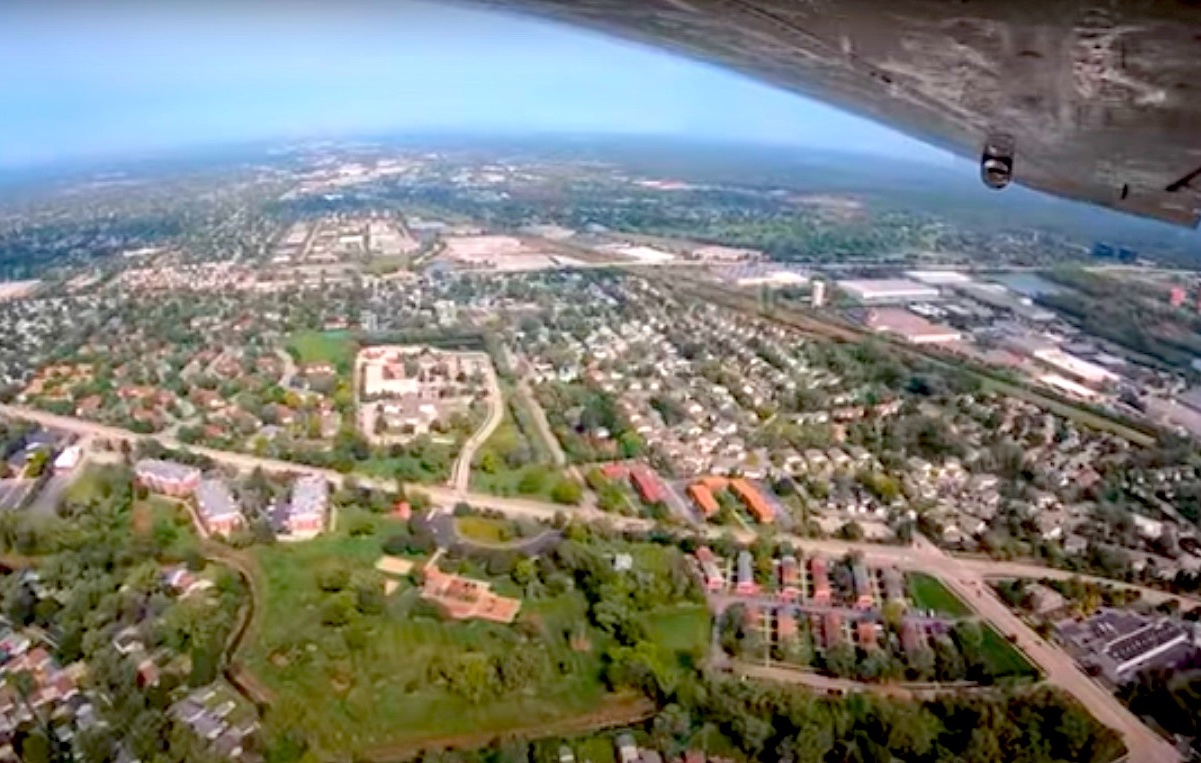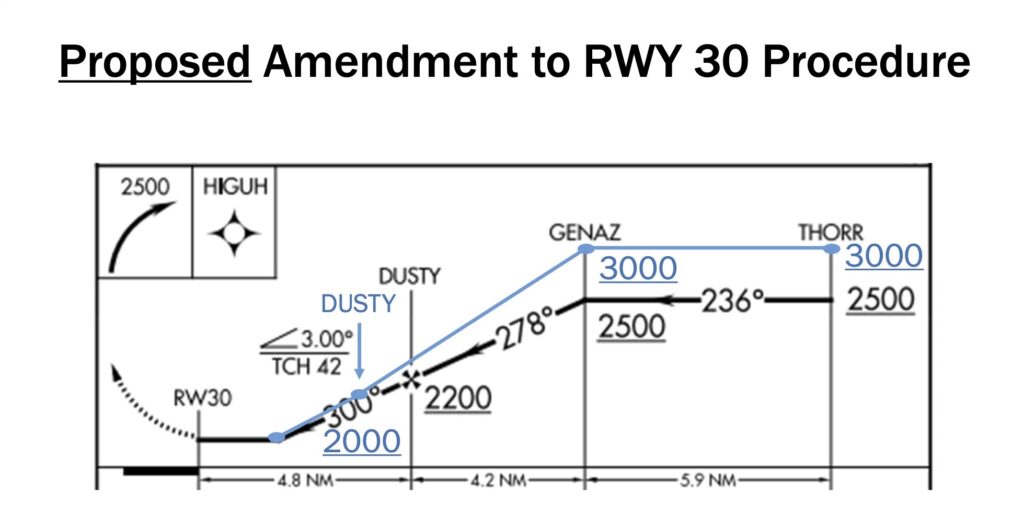
Look Out Above: Change in flight patterns has planes flying over Wilmette like never before
Up to 60 planes a day at 2,000 feet now cross Wilmette on way to Chicago Executive
A change in flight patterns into Chicago Executive Airport in Wheeling is causing headaches for residents in surrounding communities, including Wilmette.
According to officials, in November 2023, the Federal Aviation Administration amended the approach path and altitude for aircraft inbound to the suburban airport and since, upward of 60 planes a day are flying over Wilmette at a visible and audible 2,000 or so feet.
“It’s nonstop. It’s unbelievable,” said Mike McCarthy, a Wilmette resident near 7th Street and Laurel Avenue who has been monitoring the change and, with a group of neighbors, has encouraged Village of Wilmette officials to get involved.
After several failed attempts at a meeting, Wilmette Village Manager Mike Braiman, along with Village of Glenview and City of Evanston administrators, met with FAA officials on Dec. 11 to gather more information and relay concerns about the new flight patterns.

In a statement sent to The Record, an FAA spokesperson said the change was a matter of safety to mitigate conflicting air traffic into Chicago Executive and O’Hare International airports. In a 12-month period, according to FAA documents, the FAA cited 30 violations of Chicago Executive aircraft encroaching on O’Hare’s airspace.
Additionally, according to the FAA, inbound aircraft from the north regularly were lining up to land on the wrong Chicago Executive runway and the airport’s confined runway configuration had become a problem with the northern approach.
The new path, according to the FAA, sends aircraft inbound for Chicago Executive east over Lake Michigan where they turn around and are asked to descend over Wilmette, Evanston and Glenview at between 2,500-3,000 feet.
Braiman said the FAA did not approach local communities about the change in 2023. Public notice, via the FAA, is required under certain conditions; however, the FAA reportedly said that it did not notify potentially impacted communities because noise thresholds to require such a notice were not met.
“I responded that commonsense should dictate that notice, even if not required by the law, should have occurred in this instance,” Braiman wrote in an email to McCarthy and other Wilmette residents, calling the FAA’s decision to bypass notification “frustrating and disappointing.”
The airport
Built in the 1920s, Chicago Executive Airport, formerly Pal-Waukee Airport, at 1020 Plant Road in Wheeling is publicly owned by the City of Prospect Heights and Village of Wheeling. The airfield features three runways across 412 acres and is primarily used for corporate travel and recreational aviation, not by commercial airlines.
Chicago Executive is home to 325 aircraft and records up to 10,000 aircraft movements (landings and takeoffs) per month. The airport is known as a key relief valve for O’Hare, which is just seven miles to its southwest.
Prior to December 2023, aircraft typically approached Chicago Executive from the north, according to an email from the FAA’s Great Lakes Region office to McCarthy. The email explains, however, that the airport was encountering “a safety issue” between arriving and departing planes.
A new approach pattern was published on Nov. 30, 2023, directing aircraft to approach Chicago Executive from the east.
“The airspace around (Chicago Executive) is complex, structured, and busy, and involves safely managing arrival and departure traffic to ensure they de-conflict with one another,” the email to McCarthy reads. “Moving the arrival route (away from) near your home is not possible due to the complexity of their operation. We sympathize with your concern and assure you that we have thoroughly examined the situation.”
The concern
McCarthy said the air traffic is constant and disruptive. And he’s not the only one.
A survey from the Village of Wilmette about the surge in low-flying aircraft garnered 175 responses. McCarthy said the traffic came out of nowhere, and the surprise of it is just as much of a problem.
“If wanted to live next to a landing path, I could have bought a house a helluva lot cheaper in Des Plaines or something like that, where I knew what I was getting into,” he said. “This is not like someone buying a house near railroad tracks and complaining about the noise. This was a quiet neighborhood and all of the sudden there’s a landing path that no one asked for and no one approved.”
To add to the concern, the FAA stated the new approach-plan altitude is 2,500 feet; yet, in the email to McCarthy, the FAA reported that in a week sample (May 18-24, 2024), 59 planes flew over McCarthy’s home at an average altitude of 1,937 feet.
The decibel level of aircraft depends on many factors, including the type and size of the aircraft, weather, landscape, etc. A website for the UK aviation company NATS features videos with measurements of aircraft sound, with medium-sized aircraft at 1,000-2,000 feet producing sound between 65-75 decibels. According to an FAA chart, that decibel level is about equal to a busy highway at 50 feet and just below a vacuum cleaner at 10 feet.
An explainer on FAA noise and sound definitions and guidelines can be found here.
“They just slammed this thing right into us,” McCarthy said of the FAA’s new flight pattern. “It is the most heavy-handed thing I’ve ever seen. I just can’t believe it. It’s unbelievable what we put up with this past summer.”
The solution?

Braiman’s email following the meeting with the FAA delivered good and bad news to McCarthy and his neighbors.
The good is that the FAA expressed a willingness to change. The first potential change is an amendment (currently in review) to raise the approach deck to 3,000 feet for aircraft in communication with the Chicago Executive’s flight tower.
The FAA also is open to considering a more substantial shift in the flight pattern.
Then, there’s the bad news. In terms of raising the approach altitude, 3,000 feet is the highest it can go without interfering with O’Hare operations. Additionally, when weather is favorable, most aircraft are not in contact with the airport’s tower, and thus, the altitude minimum would be difficult to enforce.
And for the FAA to consider a new approach pattern, the organization would likely need evidence of a safety or operational problem as found by an aviation expert. An aviation expert, or consultant, would need to be commissioned by a regional roundtable, which Chicago Executive does not currently have.
Braiman said in his email that Wilmette, Evanston and Glenview officials will explore the possibility of a regional roundtable for Chicago Executive Airport, while at the same time looking into airspace consultants.
An example of a local airport roundtable is the O’Hare Noise Compatibility Commission, which comprises 52 municipalities and 18 school districts.
Braiman was candid about the process.
“This is not a simple undertaking and there is no guarantee that we will be successful, in fact I have a low level of confidence that we will be successful,” he wrote, before listing all of the steps a successful process would include, from getting support from airport-adjacent municipalities, the airport agreeing to a new flight path and then convincing the FAA.
Braiman concluded his email telling residents that followup meetings between local officials are already on the calendar. He assured residents that any progress with be communicated.
Concerned residents can reach out to the FAA Aviation Noise ombudsman (9-awa-noiseombudsman@faa.gov and (847) 294-8365) or file reports to the Village of Wilmette at airplanes@wilmette.com.
The Record is a nonprofit, nonpartisan community newsroom that relies on reader support to fuel its independent local journalism.
Subscribe to The Record to fund responsible news coverage for your community.
Already a subscriber? You can make a tax-deductible donation at any time.

Joe Coughlin
Joe Coughlin is a co-founder and the editor in chief of The Record. He leads investigative reporting and reports on anything else needed. Joe has been recognized for his investigative reporting and sports reporting, feature writing and photojournalism. Follow Joe on Twitter @joec2319


